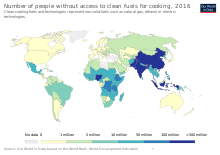
A clean-burning stove is a stove with reduced toxic and polluting emissions. The term refers to solid-fuel stoves such as wood-burning stoves for either domestic heating, domestic cooking or both. In the context of a cooking stove, especially in lower-income countries, such a stove is distinct from a clean-burning-fuel stove, which typically burns clean fuels such as ethanol, biogas, LPG, or kerosene. Studies into clean-burning cooking stoves in lower-income countries have shown that they reduce the emissions of dangerous particulates and carbon monoxide significantly, use less fuel than regular stoves, and result in fewer burn injuries. However, the emissions some supposedly clean-burning cookstoves produce are still much greater than safe limits, and in several studies in lower income countries they did not appear to be effective at reducing illnesses such as pneumonia induced by breathing polluted air, which may have many sources.
Use
Solid fuel stoves designed to be used for domestic heating, those designed to be used for cooking, and those designed for both, can all be described as being clean-burning. In all cases these types of stove are designed to produce lower emissions of particulates and other pollutants than the open fires, traditional stoves, or other appliances they replace. They have been proposed for introduction to developing countries, particularly the cooking type in order to improve air quality, and where they replace open fires they have other advantages such as a reduction in accidents due to burn injuries and house fires.
Development
A research summary of the development of clean-burning, domestic, heating stoves was published in 1982 by Flow Research Inc. Such stoves introduced in the 1980s burnt wood pellets rather than logs. By 1986, a directory was available listing 75 such stoves which had satisfied U.S. emission testing.
Operation
Clean-burning stoves can be catalytic (using catalytic converters) or noncatalytic. The noncatalytic designs recirculate smoke to achieve fuller combustion.
Once the stove is warmed to within operating temperatures, it produces no visible smoke, emitting mostly water and carbon dioxide. Non-catalytic stoves have higher emissions than the new catalytic stoves do when the latter are operated correctly (as of 2003).
A conventional domestic heating stove in 1984 emitted particulates amounting to approximately 20g per kg of fuel (0.3oz/lb). Research by the United States Environmental Protection Agency (EPA) was reported in 1986 to show that conditions such as asthma, bronchitis and emphysema may be aggravated by the use of conventional heating stoves.
Regulation
The EPA was reported as announcing plans in 1987 to encourage manufacturers to design heating stoves with reduced emissions. Clean-burning stoves are authorised for use in smoke control areas in some countries by organisations such as the EPA.
See also
- Agency for Non-conventional Energy and Rural Technology
- Ashden Awards for Sustainable Energy
- Energy for All
- International Renewable Energy Agency
- List of stoves
- Sustainable Development Goal 7
References
- Pokhrel, Amod K; Smith, Kirk R; Khalakdina, Asheena; Deuja, Amar; Bates, Michael N (June 2005). "Case–control study of indoor cooking smoke exposure and cataract in Nepal and India". International Journal of Epidemiology. 34 (3): 702–708. doi:10.1093/ije/dyi015. PMID 15737974.
- Victoria Gill (7 December 2016). "Do smoke-free stoves really save lives?". BBC News. Retrieved 7 December 2016.
- Kevin Mortimer; et al. (6 December 2016). "A cleaner burning biomass-fuelled cookstove intervention to prevent pneumonia in children under 5 years old in rural Malawi (the Cooking and Pneumonia Study): a cluster randomised controlled trial". The Lancet. 389 (10065): 167–175. doi:10.1016/S0140-6736(16)32507-7. PMC 5783287. PMID 27939058.
- James Tielsch; et al. (8 April 2016). "Effect of an improved biomass stove on acute lower respiratory infections in young children in rural Nepal: a cluster-randomised, step-wedge trial". The Lancet. 4: S19. doi:10.1016/S2214-109X(16)30024-9.
- ^ Unep Year Book 2011: Emerging Issues in Our Global Environment. UNEP/Earthprint. 2011. p. 8. ISBN 978-92-807-3101-9.
- ^ "From Suffering to Solutions: UNF-GACC Documentary "BLACK INSIDE: Three Women's Voices" Highlights Clean Cookstoves as Dramatic Global Health Solution for Women". PR Web. 30 January 2013. Archived from the original on 5 March 2016. Retrieved 22 February 2013.
- Parikh, Jyoti; Smith, Kirk; Laxmi, Vijay (1999). "Indoor Air Pollution: A Reflection on Gender Bias". Economic and Political Weekly. 34 (9): 539–544. JSTOR 4407707.
- Humber, Yuriy (5 February 2013). "Mongolia $1.25/Day Labor Amid $4K Purses Stirs Discontent". bloomberg.com. Retrieved 22 February 2013.
- Engineering development of a clean burning residential wood stove, 1 April 1982
- ^ Bonnier Corporation (December 1984). "Popular Science". The Popular Science Monthly. Bonnier Corporation: 90–92. ISSN 0161-7370. Retrieved 22 February 2013.
- ^ Kiplinger's Personal Finance. Kiplinger Washington Editors, Inc. December 1986. p. 18. ISSN 1528-9729.
- ^ Greg Pahl (1 September 2003). Natural Home Heating: The Complete Guide to Renewable Energy Options. Chelsea Green Publishing. pp. 103–104. ISBN 978-1-60358-156-1. Retrieved 22 February 2013.
- ^ Matthew Stein (31 August 2008). When Technology Fails: A Manual for Self-Reliance, Sustainability, and Surviving the Long Emergency. Chelsea Green Publishing. p. 7. ISBN 978-1-60358-095-3. Retrieved 22 February 2013.
- Bonnier Corporation (October 1976). "Popular Science". The Popular Science Monthly. Bonnier Corporation: 104–107. ISSN 0161-7370.